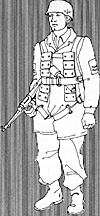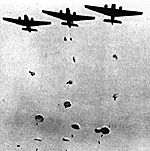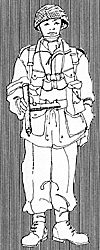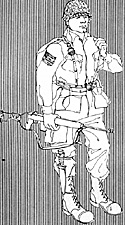Germany
 With the renunciation of the Treaty of
Versailles, Germany began to rebuild its armed forces.
Thanks to the treaty Germany was able to begin
building on a solid base of professionals. As it turned
out, younger men with new ideas that were to
revolutionize warfare, were present to influence the
growth of German armed forces.
With the renunciation of the Treaty of
Versailles, Germany began to rebuild its armed forces.
Thanks to the treaty Germany was able to begin
building on a solid base of professionals. As it turned
out, younger men with new ideas that were to
revolutionize warfare, were present to influence the
growth of German armed forces.
By the order of Hermann Goring the first units of German parachutists were activated in 1935. It was quite fortunate that the Spanish Civil War broke out when it did, for Germany sent volunteers to fight, along with new equipment and weapons. As it turned out Spain was an excellent proving ground for German weapons, among the volunteers were fifty paratroopers. The knowledge gleaned from this war helped improve German tactics and remove the bugs from weapons.
Luftwaffe General Kurt Student was placed in charge of training the paratroops. The training involved intense physical exercise to weed out the less fit plus the regular military training with emphasis placed on small arms and demolitions. When the trainee completed six jumps he was a qualified paratrooper.
It must be kept in mind that throughout the training and after, the trooper was conscious of the fact that as a paratrooper he was a member of an elite. As one of the elite he was a better soldier than his countryman, and much better than any one of his enemies. To reinforce this idea the paratroopers wore a distinctive combat uniform, a padded helmet and camouflage coverall over loose pants. High-topped boots completed the uniform, a feature common to all nations' paratroops.
Being an elite formation the paratroopers were equipped with more automatic weapons than regular infantry divisions. The paratroopers were e quipped with more heavy weapons of all categories than the regular infantry. Even when the Fallschirmjager (paratroops) lost their airborne capability they continued to be better outfitted.
First Combat
German airborne troops (the 7th Flying Division) first saw combat in the Scandinavian campaign of 1940. Somehow their use did not spark as much excitement as it warranted. It wasn't until May, 1940, with the invasion of France that the paratroops were really noticed.
Paratroopers spearheaded the advance into the Low Countries; they landed at various spots, striking at bridges and airfields. The fall of the "impregnable" fortress Eban Emael to airborne troops shocked the world. The rest of the campaign is history.
The next area of operations for the German Airborne was Greece. There were various battalion-size and smaller drops, all leading to the eventual control of Greece. Once this was completed the next objective was the island of Crete.
 Crete proved to be the first total airborne
invasion of the war. General Student commanded
the attack force, the 11th Flieger Korps, consisting of
the 7th Flieger Division and the 5th Mountain Division
(to be brought in by air). Once suitable beachheads
were held, seaborne troops would be brought in to
consolidate the gains.
Crete proved to be the first total airborne
invasion of the war. General Student commanded
the attack force, the 11th Flieger Korps, consisting of
the 7th Flieger Division and the 5th Mountain Division
(to be brought in by air). Once suitable beachheads
were held, seaborne troops would be brought in to
consolidate the gains.
The invasion started off badly, the Germans encountered twice as many defenders (42,000) than they expected. Many paratroopers fell right on top of the defenders. The Royal Navy prevented the seaborne troops from arriving. Luckily the Luftwaffe controlled the air approaches, but even then the paratroopers had to be reinforced by troops brought in on a contested airfield. The Germans eventually controlled the island, but they paid for it. The paratroops suffered 25% casualties.
Turning Point
The outcome of the battle became a turning- point in the war. When Hitler learned that over 4,000 paratroopers had died at Crete he had grave doubts as to the continued use of paratroops. He felt that the novelty of the airborne concept had been used up and the Allies would never again be surprised by their appearance. He was wrong.
There were a few more airborne operations conducted by the Germans during the rest of the war, but they can hardly be called decisive in their results. The only prominent action was the rescue of Benito Mussolini by a glider force on September 12, 1943. The last airborne operation conducted was by a battalion of troopers during the Ardennes Offensive in 1944. It was a dismal failure.
From 1943 on, ten airborne divisions were formed; numbered 1 through 10, although the 10th was little more than a battlegroup organized in April, 1945, for the defense of Berlin. All of these units were committed as ground troops and saw action in Italy, Russia, and Europe proper.
The battle of Crete was indeed a fuming-point; the Allies, however, felt differently than the Germans. They saw a continued need for paratroops.
Britain
 Winston Churchill, who had suggested the use
of landing troops by air in World War I, suggested the
creation of an airborne corps to the War Cabinet
Secretariat on June 22, 1940.
Winston Churchill, who had suggested the use
of landing troops by air in World War I, suggested the
creation of an airborne corps to the War Cabinet
Secretariat on June 22, 1940.
The first men to complete training, as rugged as German paratrooper training, but with three qualifying jumps, were the British commandos of the 11th Special Air Service Battalion. Later renamed the 1st Parachute Battalion, this unit became the nucleus of the 1st Airborne Division.
Throughout the war the British system was to pool all available units, in this case the Airborne battalions, and draw from this pool the units needed for an operation. Known as the Parachute Regiment this pool contained seventeen battalions at war's end, including both British airborne divisions, the 1st and the 6th.
The British paratroopers were authorized to wear a red beret (from which came their nickname, the Red Devils) and a shoulder patch showing Bellerophon riding Pegasus. During the Normandy invasion the actions of a group of troopers would be rewarded when the bridge where they fought was renamed Pegasus Bridge. Their equipment was the same as regular infantry though the paratroops were supplied with more Sten sub-machine guns and Bren light machine guns.
In its final form the British Airborne Division consisted of two parachute brigades and a glider brigade. Attached were artillery units, engineers, medics, and a light tank squadron brought in by glider.
Two gliders were produced by the British, the Horsa was the troop carrier, capable of carrying 29 troopers or a 75mm howitzer, and the Hamilcar was primarily the freight carrier, big enough to carry a light tank. To unload, the nose of the Hamilcar was hinged to swing outward.
The first operation by the British Airborne, in February, 1941, was against an aqueduct in southern Italy. The second, in November, 1941, was against Axis airfields in the Western Desert. On this occasion a strong wind totally scattered the unit involved. Of fifty-four men dropped, twenty-one made it to safety. These men later trained Greek and Iraqi troops in airborne procedures. Small units, usually numbering less than 100 men, were dropped to perform specific missions. The third and most spectacular raid was on a Gemman radar station on the French coast, on February 27, 1942. 119 paratroopers landed on the station and proceeded to photograph and dismantle parts of the installation for later study in England.
Except for a few large-scale drops involving divisions or brigades, throughout the war most British operations were conducted by small unite against targets as detailed above. These operations were always done in commando-fashion, intent on hitting the enemy and quickly withdrawing.
United States
 Before the large airborne assaults executed by the Allies can be explained, the creation and growth of the American Airborne should be detailed.
Before the large airborne assaults executed by the Allies can be explained, the creation and growth of the American Airborne should be detailed.
As with the other countries' Airborne units, the United States' paratroops begin in World War I. This war was the first to use aircraft, although the possibilities of this machine could only be guessed at at that time.
At Kelly Field, Texas, during the late 1920's a demonstration was arranged by General Billy Mitchell. This demonstration was six soldiers jumping by parachute from a Martin Bomber. Within three minutes of landing these soldiers were ready for action. Of those present no one was impressed. The idea for parachute troops was mentally filed away.
One decade later the idea was forced back into prominence by the airborne assaults of the Axis. On April 25, 1940, the War Department authorized the creation of a "Test Platoon" for study of the possibilities inherent in airborne operations.
The test platoon was composed of two officers and forty-eight men, the date was July 11, 1940. The men trained on 250-foot Parachute Drop towers in Hightstown, New Jersey which had been used at the 1939 New York World's Fair and were assembled on the premises of their owners, the Safe Parachute Company. Two towers were bought by the Army and moved to Fort Benning, Georgia, where the Parachute School was established, May 15, 1942.
The first mass jump by the Test Platoon was made on August 29, 1940. Using members of the Test Platoon as cadre, the 501st Parachute Battalion was organized under command of Major William Miley (who later became a Major-General commanding the 17th Airborne Division).
October 10, 1941, saw the activation of the 88th Glider Infantry Battalion under Lt. Colonel Elbridge Chapman (later Major-General in command, 13th Airborne Division), to test glider and glider-borne procedures.
In February, 1942, the War Department authorized the formation of four parachute regiments. Each regiment took the name of one of the four existing parachute battalions, thus, the 501st Parachute Infantry Regiment was created from the 501st Parachute Battalion.
The War Department approved activation of two airborne divisions in 1942. The first was the 82nd (the All American), the second was the 101st (the Screaming Eagles). Total manpower for these divisions was first set at approximately 8,500. However, it was undecided what proportion there would be of parachute to glider troops. Thus, between 1942 and war's end, there were at least three different divisional configurations.
Training for the Americans was on a par with the British, though the American troopers had to make five jumps to qualify. The Airborne Division was equipped like regular divisions. As with other airborne divisions there were more automatic weapons, such as the Browning Automatic Rifle (BAR), the M-3 .45 caliber "grease gun," and the Thompson sub-machine guns. When they jumped, the troopers carried an assortment of equipment: entrenching tool, a knife with brass knuckles on the handle, first-aid kit, their weapon plus extra ammunition, gas mask, 3 days' K and D rations, water, water-purification tablets, grenades, and whatever odds and ends they wanted to take with them.
Equipment chutes would carry extra grenades and ammunition, Browning light machine guns, extra bazooka rockets, heavy explosives, extra mortar (60mm and 81mm) shells, medical supplies and food.
Transport for the divisions was provided by the AAF Troop Carrier Command. The planes used were the Douglas C-47 Skytrain, eventually used by the British. It had a range of 2,125 miles and could hold twenty-eight fully-equipped men. The main U.S. glider was the Waco CG4A Hadrian glider, capable of carrying thirteen men. As was discovered during the Normandy invasion, the CG4A was much stronger structurally than the Horsa.
Initially, divisional artillery had thirty-six 75mm pack howitzers in three battalions delivered by parachute. Later one battalion was converted into 105mm howitzers brought in by gliders.
First Combat: Vichy Africa
The first combat action seen by American paratroopers was during the North African invasion on November 8, 1942. The mission was to seize two Vichy-controlled airfields. What was peculiar about the assignment was that no one knew if the French would fight or not. The task was accomplished by the 2nd Battalion, 503rd PIR, later redesignated the 509th Parachute Battalion. The rest of the 503rd was sent to the Pacific.
For the next nine months the 509th was the only American Airborne unit in the Mediterranean. Meanwhile the 503rd made its first combat jump on Salamaua, on September 5, 1943. A year later the 503rd made its third jump, to help recapture Corregidor.
On May 11, 1943, the 82nd Airborne Division landed by boat at Casablanca. The 82nd's units were the 504th PIR, 505th PIR, and the 325th Glider Infantry Regiment. Between 8 and 14 July, 1943, two American parachute regiments and one brigade each of British paratroops and glider troops made drops on Sicily.
The Sicily assault was marred by numerous difficulties. As the 504th approached, Allied anti- aircraft batteries opened fire. Planes dispersed, many troopers were dropped on the wrong areas. The Troop Carrier pilots were inexperienced, it wasn't until after Nommandy that the pilots stayed on their course no matter what. But in the meantime many troopers were still dispersed.
On September 14, 1943, the 82nd reinforced the Allied beachhead at Salerno, Italy. When the beachhead was secure the 82nd was relieved and sent to England, all except for the 504th PIR, which stayed and fought at Anzio from October, 1943, to April, 1944.
Invasion of Europe
For the coming invasion of Europe three Airborne divisions were to be employed, with an o ther division held in reserve. Because of shortcomings revealed during the Italian campaign, the two U.S. divisions that were to be used had their strength increased. Each received another PIR and the two split a glider regiment between them. The drops did not go according to plan, a large majority of the troopers were dispersed away from their DZs. After D-Day the statistics of the first twenty-four hours of D-Day have been officially estimated at 2,499 casualties for the 82nd and 101st, approximately fifteen per cent total airborne strength.
There were only three more jumps made in the ETO. The invasion of southern France was spearheaded by the First Airborne Task Force on August 14, 1944. Operation Market Garden saw the 82nd, 101st, and British 1st Airborne Divisions drop in a line leading from the front lines of the British Second Army in Holland to Amhem. Operation Varsity occurred on March 24, 1945, and was conducted by the 6th and recently arrived U.S. 17th Airborne Division. This operation was intended to help the Allied crossing of the Rhine at Wesel.
Although only the drops have been discussed so far, it should be emphasized that, contrary to proper airborne doctrine, once the airborne troops were down, they continued to fight as ground troops. Correct airborne doctrine calls for the airborne troops to be relieved as soon as possible. To keep elite troops in the front lines, an all too common occurrence in World War II, was condemned as a waste of talent and manpower.
Paratroops started the war with the specific purpose of striking at bridges and fortifications and disrupting the enemy's rear areas. As the war progressed their role changed, they became the shock troops. But one shortcoming was never relieved: the paratroopers had few heavy weapons, and tanks became a particular problem. The troopers at Arnhem landed amidst panzer units; the question was not whether they could survive, but how long. After the war the U.S. began research into a tank that could be used by paratroopers.
Since the war there have been a number of airborne operations, the Middle East, Korea, in Vietnam by the French and even by the U.S. The Airborne is quietly becoming a lost weapon, and few notice its passing.
More Airborne
-
History and Development
TO&E: German, British, American Divisions (slow: 215K)
Crete and D-Day Invasions
Back to Conflict Number 3 Table of Contents
Back to Conflict List of Issues
Back to MagWeb Master Magazine List
© Copyright 1998 by Dana Lombardy
This article appears in MagWeb (Magazine Web) on the Internet World Wide Web.
Other military history articles and gaming articles are available at http://www.magweb.com
E-mail MagWeb if you find broken links, missing graphics, or other problems.